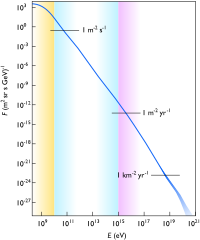
Photo from wikipedia
We study the surface brightness fluctuations of the cosmic X-ray background (CXB) using Chandra data of XBOOTES. After masking out resolved sources we compute the power spectrum of fluctuations of… Click to show full abstract
We study the surface brightness fluctuations of the cosmic X-ray background (CXB) using Chandra data of XBOOTES. After masking out resolved sources we compute the power spectrum of fluctuations of the unresolved CXB for angular scales from ~2 arcsec to ~3 deg. The non-trivial large-scale structure (LSS) signal dominates over the shot-noise of unresolved point sources at all scales above ~1 arcmin and is produced mainly by the intracluster medium (ICM) of unresolved clusters and groups of galaxies, as shown in our previous publication. The shot-noise-subtracted power spectrum of CXB fluctuations has a power-law shape with the slope of $\Gamma = 0.96 \pm 0.06$. Its energy spectrum is well described by the redshifted emission spectrum of optically-thin plasma with the best-fit temperature of $T \approx 1.3$ keV and the best-fit redshift of $z \approx 0.40$. They are in good agreement with theoretical expectations based on the X-ray luminosity function and scaling relations of clusters. From these values we estimate the typical mass and luminosity of the objects responsible for CXB fluctuations, $M_{500} \sim 10^{13.6}\,{\rm M}_{\odot}/h$ and $L_{0.5-2.0\,{\rm keV}} \sim 10^{42.5}$ erg/s. On the other hand, the flux-weighted mean temperature and redshift of resolved clusters are $T \approx 2.4$ keV and $z \approx 0.23$, confirming that fluctuations of unresolved CXB are caused by cooler (i.e. less massive) and more distant clusters, as expected. We show that the power spectrum shape is sensitive to the ICM structure all the way to the outskirts, out to $\sim{\rm few}\times R_{500}$. We also look for possible contribution of the warm-hot intergalactic medium (WHIM) to the observed CXB fluctuations. Our results underline the significant diagnostics potential of the CXB fluctuation analysis in studying the ICM structure in clusters.
Journal Title: Monthly Notices of the Royal Astronomical Society
Year Published: 2018
Link to full text (if available)
Share on Social Media: Sign Up to like & get
recommendations!